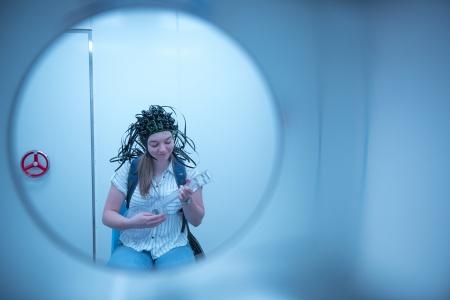
Credit: University of Nottingham
A new type of wearable brain scanner, designed to allow people to move freely whilst being scanned, is a step closer to being used in hospitals with the launch of a new partnership.
The University of Nottingham has partnered with Kent based company Magnetic Shields Limited (MSL) to launch a new spin-out company, Cerca Magnetics Limited (Cerca) to bring the world’s most advanced functional brain scanner to market. The Cerca Scanner will offer an unprecedented window on brain function and give new hope to people suffering with severe neurological illnesses, like epilepsy.
Researchers in the Sir Peter Mansfield Imaging Centre and School of Physics and Astronomy, have been developing the technology for the wearable brain scanner for the past 5 years, in collaboration with neuroscientists at University College London. Their research, funded by the UK Quantum Technologies Programme, Innovate UK, and Wellcome, has demonstrated the ability to create images of the brain with millimetre accuracy, even when the person being scanned is moving. This opens up new possibilities for imaging babies and children.
This new wearable scanner is based on a technique called magnetoencephalography (MEG), in which the tiny magnetic fields generated by electrical current flow in brain cells are measured. Mathematical reconstruction of those fields generates images showing moment-to-moment changes in brain activity. These unique pictures can tell us how our brains respond when we perform a mental task, and more importantly, how things begin to go wrong in neurological or mental health problems.
Whilst other MEG scanners exist, the Cerca System is unique since it is the only “wearable” MEG system allowing patients to move freely during the scan. It also uniquely adapts to different head sizes, making it possible to scan adults, or babies, using the same system. It offers considerably higher sensitivity and spatial specificity compared to the best existing systems and all of this can be achieved at lower cost.
Dr. Elena Boto, University of Nottingham scientist and chief technology officer for Cerca, said: “5 years ago, we started with a few equations on the back of an envelope, and a few lines of computer code to simulate a system. To have seen this mature into a commercialisable imaging system, which can outperform anything available currently, has been remarkable. There are many advantages to our system but for me the biggest is the ability to scan babies and children. Neurological disorders, like epilepsy, often strike in young children and this new system will provide new information to medical professionals which they can use in treatment planning.”
The perfect partnership
Because the magnetic fields from the brain are so small, the scanner needs to sit in a well-controlled magnetic field environment. MSL are the world leaders in magnetic shielding and had already been working with University of Nottingham scientists to develop magnetically-shielded enclosures into which the scanner (and other magnetically-sensitive devices) can be installed. The new partnership now takes this one step further, with Cerca selling the complete integrated brain imaging system.
David Woolger, CEO of Cerca said: “The commercial opportunity is extremely exciting. The system that has been developed in Nottingham is remarkable, but its real impact will only be realised if the technology can be spread around the world. Cerca are already working with some of the world’s best research laboratories to deliver our first generation of system for deployment in the field. We hope and believe that within 3-5 years, we can see the technology becoming commonplace in hospitals”.
Quantum technology
Conventional MEG scanners are based on magnetic field detectors that must be cooled to -269 degrees celsius in order to operate. Consequently they are extremely large and cumbersome; the need for thermal insulation means it is hard to get ‘supercooled’ sensors close to the head (reducing sensitivity and spatial accuracy), and because the sensors must be static, the system cant adapt to different head shapes and sizes and patients must remain still for very long periods. These systems are also extremely expensive. The new system is based upon recently developed “quantum” sensors, which use the fundamental properties of atoms to sense local magnetic fields. These new sensors, called optically-pumped magnetometers or OPMs, do not require cryogenic cooling. They are also extremely small and lightweight (similar in size to a Lego brick). This means they can be mounted in a helmet which the patient wears. The helmet can adapt to any head shape or size, and because it is lightweight and moves with the head, it is completely insensitive to motion. In addition, because no thermally insulating gap between scalp and sensor is required, the sensors get closer to the head and therefore capture a higher amplitude signal, consequently gaining better data.
Professor Matt Brookes, who leads MEG research in Nottingham, said: “The combination of quantum technology and novel magnetic shielding has offered something completely unique – a wearable brain scanner that lifts the restrictions surrounding conventional imaging systems of this type. The Cerca System will provide an extremely advanced device for neuroscientific experimentation. More importantly it will enable a new way to investigate myriad brain health conditions. Understanding the human brain and the many severe and debilitating conditions that affect it is one of the biggest challenges for 21st century science. This new technology will provide one of the platforms from which scientists and clinicians can begin to meet that challenge.”
###
Support for the creation of Cerca has been provided by Nottingham Technology Ventures with seed funding from the University of Nottingham alongside MSL. The underlying research was funded by the Engineering and Physical Sciences Research Council through the Quantum Technology Hub for Sensing and Timing; part of the £1bn UK National Quantum Technologies Programme. Research has also been funded by Innovate UK and by a Wellcome Trust Collaboration in Science grant awarded jointly to the University of Nottingham and partners at University College London.
Media Contact
Jane Icke
[email protected]




